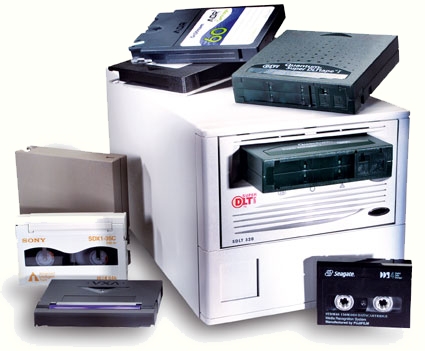Backing Up with Tape Drives: Security Is What Counts
Good-Value Backup
There are two types of data: those that have already been archived by backup and those that have not yet been lost. A reliable system of data protection is the backbone of any company. A study by the German Industry Liability Association (HDI) backs this up (so to speak). It says that, "40 percent of companies that experienced a system crash without a backup are likely to fold within two years at the latest."
The HP SDLT 320 is the fastest drive in the test and has the highest capacity. One tape has space for 320 GB, which is ideally filled in 2.8 hours. HP is the "Editors' Choice" in the 50 GB and over category. In the under-50 GB category, the Tandberg SLR100 wins the test with its good performance and comprehensive equipment.
Large discrepancies between the devices are revealed in their operating costs. At around $4000, a pricey tape drive such as HP's test victor is actually cheaper in terms of running costs. Using it as an example, backing up one gigabyte of data costs just $0.94. On the other hand, the user has to shell out a whopping $2.48 for every gigabyte using Tandberg's DLT VS 80, despite the device's price tag of only $1,300.
Transfer Rates: Unkept Promises
The manufacturers make claims regarding data speeds that they cannot match in practice. Throughput is generally configured to completely write a tape in two to three hours. Negative outliers can be found in both categories. The Tandberg DLT VS 80 and the ExaByte VXA-2, for example, need around two hours and 45 minutes to fill a tape with data. And Onstream's ADR2 120Si took four hours and ten minutes to write a tape in the laboratory.
The transfer rate is decisive in dividing the devices into classes. Tape drives with a transfer rate of 2.4 to 3.0 MBytes per second are suitable for entry-level servers. This category is dominated by DAT (DDS 4), DLT1 and VXA-1 tape technologies. Capacities lie between 20 and 60 net GBs.
Typical candidates for midrange servers achieve throughput of 4.0 to 6.0 MB per second. These include the ADR2, the SLR, the DLT7000/ 8000, the VXA-2, and the AIT-1 and AIT-2, with net capacities of between 35 and 80 GB.
SDLT, AIT-3 and LTO technologies are suitable for high-end servers and can attain transfer rates of up to 16 MB/s. Capacities here lie between 100 and 160 GBytes net.
Get Tom's Hardware's best news and in-depth reviews, straight to your inbox.
The test candidates were divided into two categories in the lab according to their storage capacities: models with a maximum net capacity of up to 50 GB, and devices with more than 50 GB. That said, the capacities claimed by the manufacturers are not borne out in practice. In addition, data compression is frequently already active on servers. All that means that a reduction in data size on the tape drive is not possible. The lab tests confirm this: the Viper 200 tape is already full at 110 GBytes.
